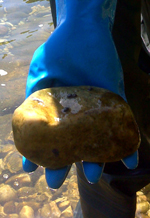Habitat

Biomphalaria snails in situ on a rock in Uganda, lifted from the shallow rocky area in the background
B. choanomphala can survive in varied climatic and environmental conditions, although its primary habitat appears to be quite specific:
- large, non-turbulent lakes and ponds, particularly with:
- a rocky or sandy substrate
- patches of aquatic vegetation (which it feeds and breeds upon)
Lake Victoria
Lake Victoria is B. choanomphala's largest expanse of suitable habitat. Its size means that even within it there are numerous habitat types and changes in water chemistry.
Snails have been found:
- living in water with very large ranges of pH (from as low as 6 to as high as 10)
- clinging directly to rocks and feeding on algae
- living within clumps of many different aquatic plants, including the invasive water hyacinth which was introduced last century from the Amazon basin
These observations emphasise the adaptability of B. choanomphala and suggest how it has survived so successfully even as human disturbance has radically altered the habitats and water chemistry of Lake Victoria and the other East African Great Lakes.